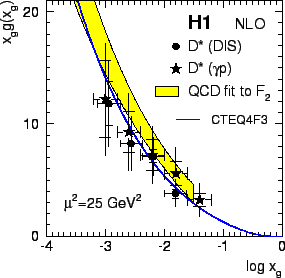



Next: Photon Structure
Up: Theory
Previous: Perturbative Calculations
Contents
The process of heavy quark production is directly sensitive
to the distributions of heavy quarks (massless approach,
fig. 2) and/or gluons
(massive approach, fig. 3) in the proton.
In global fits to inclusive data, the gluon distribution  is
extracted by analysis of the scaling violations of the proton structure
function assuming a certain functional form for
is
extracted by analysis of the scaling violations of the proton structure
function assuming a certain functional form for  .
In contrast, heavy quark processes can be used to determine the
gluon distribution directly, i.e.by reconstruction of the kinematics
of the interacting partons from the measurement of the hadronic final
state. Such direct measurements are complementary to the indirect
analyses and - although still limited in statistics - they are
in principle more sensitive to local variations.
In fig. 4 a comparison is shown of the
gluon distribution as extracted from global fits and from two sets
of charmed
.
In contrast, heavy quark processes can be used to determine the
gluon distribution directly, i.e.by reconstruction of the kinematics
of the interacting partons from the measurement of the hadronic final
state. Such direct measurements are complementary to the indirect
analyses and - although still limited in statistics - they are
in principle more sensitive to local variations.
In fig. 4 a comparison is shown of the
gluon distribution as extracted from global fits and from two sets
of charmed  -meson data collected at H1 in
DIS and in photoproduction [4].
The gluon density is extracted from the
-meson data collected at H1 in
DIS and in photoproduction [4].
The gluon density is extracted from the  cross section using an
unfolding procedure in which effects from gluon radiation and
fragmentation are removed. The relative
contribution from
cross section using an
unfolding procedure in which effects from gluon radiation and
fragmentation are removed. The relative
contribution from  production via quarks from the proton
is subtracted.
For the different bins of the measurement the gluon densities
are obtained at different factorization scales as given by the
phase space of the particular bin and evolved to a scale
production via quarks from the proton
is subtracted.
For the different bins of the measurement the gluon densities
are obtained at different factorization scales as given by the
phase space of the particular bin and evolved to a scale
 GeV
GeV .
.
Figure 4:
Gluon distributions  as extracted
from
as extracted
from  data [4].
The systematic error is a quadratic sum of all contributions
and is dominated by the theoretical uncertainty on the
charm quark mass (DIS sample) and the renormalization and factorization
scale (photoproduction).
data [4].
The systematic error is a quadratic sum of all contributions
and is dominated by the theoretical uncertainty on the
charm quark mass (DIS sample) and the renormalization and factorization
scale (photoproduction).
 |




Next: Photon Structure
Up: Theory
Previous: Perturbative Calculations
Contents
Andreas Meyer
2006-02-13

